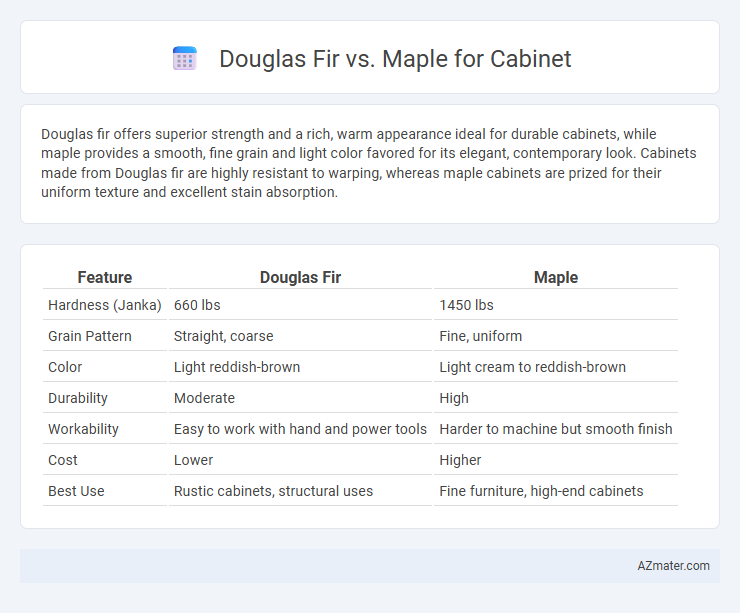Douglas fir offers superior strength and a rich, warm appearance ideal for durable cabinets, while maple provides a smooth, fine grain and light color favored for its elegant, contemporary look. Cabinets made from Douglas fir are highly resistant to warping, whereas maple cabinets are prized for their uniform texture and excellent stain absorption.
Table of Comparison
| Feature | Douglas Fir | Maple |
|---|---|---|
| Hardness (Janka) | 660 lbs | 1450 lbs |
| Grain Pattern | Straight, coarse | Fine, uniform |
| Color | Light reddish-brown | Light cream to reddish-brown |
| Durability | Moderate | High |
| Workability | Easy to work with hand and power tools | Harder to machine but smooth finish |
| Cost | Lower | Higher |
| Best Use | Rustic cabinets, structural uses | Fine furniture, high-end cabinets |
Introduction: Douglas Fir vs Maple for Cabinetry
Douglas Fir features a straight grain and warm reddish-brown color ideal for rustic-style cabinetry, offering impressive strength and durability. Maple provides a smooth, light-colored surface with fine grain, preferred for modern and traditional cabinetry due to its excellent workability and resistance to denting. Both woods deliver durability, but Douglas Fir excels in structural stability while Maple stands out for its refined appearance and versatility in finishes.
Wood Grain and Aesthetics Comparison
Douglas fir features a prominent, straight grain with a coarse texture that highlights its natural knot patterns, offering a rustic and warm aesthetic ideal for traditional or country-style cabinets. Maple displays a fine, uniform grain with a smooth texture and fewer knots, providing a sleek, clean, and modern appearance that enhances contemporary cabinetry. The contrasting grain patterns make Douglas fir more visually dynamic, while maple's subtle grain supports minimalist design preferences in kitchen or bathroom cabinets.
Hardness and Durability Differences
Douglas fir offers moderate hardness with a Janka rating around 660, making it softer and more prone to dents compared to maple, which boasts a higher Janka hardness of approximately 1450. Maple's superior density enhances its durability, enabling cabinets to withstand heavy use and resist scratches and wear over time. Douglas fir's softer nature provides a warm, rustic look but requires more maintenance to preserve its appearance in high-traffic cabinetry applications.
Workability and Ease of Machining
Douglas fir offers excellent workability due to its straight grain and softer texture, making it easy to cut, shape, and sand for cabinets. Maple, especially hard maple, is denser and tougher, providing superior durability but requiring sharper tools and more effort during machining. Cabinet makers often prefer Douglas fir for quicker, hassle-free work, while maple is chosen for its strength despite more challenging machining conditions.
Finishing and Staining Characteristics
Douglas fir offers a coarse, pronounced grain that absorbs stain unevenly, often resulting in a blotchy finish, which makes it best suited for natural or clear finishes enhancing its warm reddish-brown hues. Maple, with its fine and smooth grain structure, takes stains more uniformly, allowing for a consistent color application that ranges from light amber to rich browns, ideal for achieving refined and polished cabinetry looks. Both woods respond well to sealers and topcoats, but maple's dense grain requires careful sanding and conditioning to prevent blotching during staining.
Cost Considerations of Douglas Fir and Maple
Douglas fir typically offers a more cost-effective option for cabinets compared to maple due to its faster growth rate and wider availability, resulting in lower lumber prices. Maple, especially hard maple, commands a higher price because of its density, durability, and finer grain, which are preferred for premium cabinetry. Budget-conscious projects often favor Douglas fir, while maple is selected for its long-term value and aesthetic appeal despite higher upfront costs.
Environmental Impact and Sustainability
Douglas fir cabinets have a lower environmental impact due to their faster growth rate and widespread availability, making them a more renewable resource compared to maple. Maple wood, while durable, grows more slowly and requires longer periods for forest replenishment, potentially leading to higher ecological footprints. Sustainable sourcing of both woods is crucial, but Douglas fir's quicker regeneration and common certification under sustainable forestry programs like FSC provide an edge in eco-friendliness for cabinetry.
Suitability for Modern and Traditional Kitchens
Douglas fir's warm tones and straight grain make it ideal for modern kitchens seeking a sleek, natural look, while its durability supports long-lasting cabinetry. Maple, known for its fine, uniform texture and light color, complements traditional kitchens with a classic, timeless appeal and offers excellent resistance to wear and staining. Both woods provide versatile options, but Douglas fir leans toward a contemporary vibe, whereas maple enhances traditional design elements.
Maintenance and Longevity
Douglas fir cabinets offer excellent durability with moderate maintenance, requiring occasional sealing or varnishing to protect against moisture and wear. Maple cabinets are highly resistant to dents and scratches, providing long-lasting beauty with minimal upkeep, typically needing only regular cleaning and periodic refinishing. Both woods deliver strong longevity, but maple's denser grain structure enhances its resilience in high-traffic kitchen environments.
Which Is Best: Choosing Between Douglas Fir and Maple
Douglas fir offers a strong, lightweight structure with a straight grain ideal for rustic or traditional cabinet styles, while maple provides a harder, denser wood with a smooth, fine grain perfect for sleek, modern designs. Douglas fir is more affordable and easier to work with but less resistant to dents and scratches compared to maple, which is highly durable and maintains its smooth finish over time. Choosing the best wood depends on budget, desired durability, and aesthetic preference, with maple favored for longevity and elegance, and Douglas fir chosen for cost-efficiency and natural warmth.

Infographic: Douglas fir vs Maple for Cabinet
 azmater.com
azmater.com